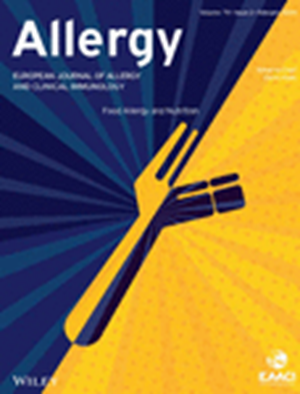Distinct Roles of IL-4, IL-13, and IL-22 in Human Skin Barrier Dysfunction and Atopic Dermatitis.
IF 12
1区 医学
Q1 ALLERGY
引用次数: 0
Abstract
BACKGROUND Atopic dermatitis (AD) is a chronic type-2 inflammatory skin disease characterized by eczema and epithelial barrier dysfunction. Along with the type-2 cytokines IL-4 and IL-13, IL-22 contributes to AD pathogenesis. To date, most skin studies rely on reconstructed keratinocytes, which do not represent the real skin response. OBJECTIVE Here, we report the distinct effects of IL-4, IL-13, and IL-22 on bio-stabilized human skin with intact barriers and immune cells. METHODS Spatial transcriptomics on AD-lesions and non-lesional skin was performed. Ex vivo skin barrier integrity was evaluated using electrical impedance spectroscopy (EIS), RNA-sequencing, and untargeted proteomics, complemented by analyses of skin biopsies from dupilumab-treated AD patients. RESULTS Spatial transcriptomics demonstrated that AD lesions showed reduced expression of key barrier genes, including CLDN1, FLG, and FLG2. IL-4, IL-13, and IL-22 disrupted the skin barrier in the ex vivo human skin. Combining type-2 cytokines and IL-22 alone downregulated genes critical for barrier function and keratinization. In addition, IL-4 and IL-13 downregulated antimicrobial peptides, while IL-22 upregulated them. Interestingly, IL-4 and IL-13 reduced IL-22Rα1, and IL-22 upregulated IL-4Rα, suggesting immune cross-regulation. Proteomic analysis confirmed that all three cytokines (IL-4, IL-13, and IL-22) reduced the expression of key skin barrier proteins, particularly filaggrin and claudin-1. Dupilumab treatment of AD patients for 3 months restored IL-4/IL-13-dysregulated genes, whereas it had limited effect on IL22-associated pathways. CONCLUSION This comprehensive study provides insights into the distinct immune profiles following IL-4, IL-13, and IL-22 stimulation on human skin, highlighting their complex interplay in disrupting skin barrier function and modulating innate immune responses.IL-4、IL-13和IL-22在人类皮肤屏障功能障碍和特应性皮炎中的独特作用
背景:过敏性皮炎(AD)是一种以湿疹和上皮屏障功能障碍为特征的慢性2型炎症性皮肤病。IL-22与2型细胞因子IL-4和IL-13一起参与AD的发病。迄今为止,大多数皮肤研究依赖于重建的角质形成细胞,这并不能代表真正的皮肤反应。目的在此,我们报道了IL-4、IL-13和IL-22对具有完整屏障和免疫细胞的生物稳定人皮肤的不同作用。方法对ad病变皮肤和非病变皮肤进行空间转录组学检测。体外皮肤屏障完整性通过电阻抗谱(EIS)、rna测序和非靶向蛋白质组学进行评估,并辅以dupilumab治疗的AD患者的皮肤活检分析。结果空间转录组学结果显示,AD病变中CLDN1、FLG和FLG2等关键屏障基因的表达降低。IL-4、IL-13和IL-22在离体人皮肤中破坏皮肤屏障。联合2型细胞因子和IL-22单独下调对屏障功能和角化至关重要的基因。此外,IL-4和IL-13下调抗菌肽,而IL-22上调抗菌肽。有趣的是,IL-4和IL-13降低IL-22Rα1, IL-22上调IL-4Rα,提示免疫交叉调节。蛋白质组学分析证实,所有三种细胞因子(IL-4、IL-13和IL-22)都降低了关键皮肤屏障蛋白的表达,尤其是聚丝蛋白和聚丝蛋白-1。Dupilumab治疗AD患者3个月可恢复IL-4/ il -13失调基因,而对il - 22相关通路的影响有限。这项综合研究揭示了IL-4、IL-13和IL-22刺激人体皮肤后不同的免疫特征,强调了它们在破坏皮肤屏障功能和调节先天免疫反应中的复杂相互作用。
本文章由计算机程序翻译,如有差异,请以英文原文为准。
求助全文
约1分钟内获得全文
求助全文
来源期刊

Allergy
医学-过敏
CiteScore
26.10
自引率
9.70%
发文量
393
审稿时长
2 months
期刊介绍:
Allergy is an international and multidisciplinary journal that aims to advance, impact, and communicate all aspects of the discipline of Allergy/Immunology. It publishes original articles, reviews, position papers, guidelines, editorials, news and commentaries, letters to the editors, and correspondences. The journal accepts articles based on their scientific merit and quality.
Allergy seeks to maintain contact between basic and clinical Allergy/Immunology and encourages contributions from contributors and readers from all countries. In addition to its publication, Allergy also provides abstracting and indexing information. Some of the databases that include Allergy abstracts are Abstracts on Hygiene & Communicable Disease, Academic Search Alumni Edition, AgBiotech News & Information, AGRICOLA Database, Biological Abstracts, PubMed Dietary Supplement Subset, and Global Health, among others.
 求助内容:
求助内容: 应助结果提醒方式:
应助结果提醒方式:


